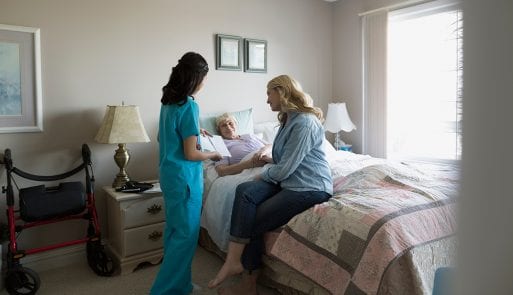
Credit: hhhn.org
Providing easier access to both hospice and palliative care services is becoming increasingly important for health systems and hospitals. In many cases, increased access can be achieved via home-based services and/or telemedicine.
The nonprofit research group Florida TaxWatch estimates that home-based palliative care could significantly impact health care costs nationwide. In fact, the group projects that palliative care in general could cut nationwide costs by $103 billion within 20 years. Palliative care can also reduce costs by $4,000 per patient according to a July 2017 report in Health Affairs. Access to palliative care similarly minimizes 911 call frequency, emergency room visits and unneeded hospitalizations.
Hospice and palliative care services are usually clumped together in discussions of end-of-life care. And palliative care is one aspect of hospice care. However, palliative care can be initiated at any time after a person is diagnosed with a life-limiting illness. It’s not just for people who are terminally ill. Still, the two are inevitably linked, because many people only think of palliative care in a hospice framework.
Regardless of when palliative care is started, the end-goal is the same: to improve a person’s quality of life. This can include aspect of the person’s physical, psychological, social, spiritual or existential needs. And so increasing access to hospice and palliative care services is crucial if we are to better serve both our chronically and terminally ill communities.
Home-Based Palliative Care
There are numerous hospitals and health care systems across the United States that are expanding palliative care services to patients’ homes.
CHI St. Alexius Health System in North Dakota has outpatient and home-based services as part of its palliative care program. The inpatient palliative care team at the hospital there became distinguished from its hospice service in 2013.

Credit: aarp.org
“For years the hospice team would talk about how they wished they could help a patient who was not yet terminal. Many patients could benefit from palliative care, but at the time we had no way to serve them,” Laura Archuleta, MD, the program’s medical director, told Hospice News. “Now that we are expanding into the home, it was again about seeing where the need really lies. The inpatient program was a great start, but patients were being discharged just as we were getting to know them. We knew we needed ambulatory and home-based options to continue the work.”
This is a major reason why home-based palliative care services in particular are important. If someone has been discharged from the hospital but can still benefit from palliative care, why shouldn’t they be able to continue their treatment?
SSM Health is a health system operating in Missouri, Wisconsin, Oklahoma and Illinois. They offer home health care, hospice and palliative care services through the SSM Health at Home division. They expect home palliative care to grow the most in the coming years.
“Palliative care is that gap care that’s in between home health and hospice for chronic care patients,” Robert Pritts, president of SSM Health at Home, said. “We do a lot [of] work with hospice and home health, and we’re starting to get into what they consider to be transitional care, which is nurse practitioners that are actually able to look at what’s going on in the home. We literally hired a chief medical officer for palliative care in Wisconsin, who [is helping to] develop the whole entire gap program.”
Access For Rural Communities
Another way health systems can improve hospice and palliative care services is by increasing access for rural communities. According to a 2015 study, rural families have less access to hospice care than those in more urban areas. And rural counties are less likely to have Medicare-certified hospice than urban counties.
Resolution Care is a palliative care provider based out of Eureka, California. Resolution maintains a virtual hospice program so clinicians can support patients and families in real time. They have tablets with data plans in circulation and other methods to help patients with limited access in the rural areas they serve.
“Rural palliative care is different. The expertise that organizations have developed around delivering palliative care in other geographic areas doesn’t always naturally translate,” said Brian Mistler, chief operating officer of Resolution Care. “Also, a lot of the patient population that we see served in rural communities don’t have the same privileges that some of the rest of us have. It’s hard to wrap our minds around the impact that lack of access to the social determinants of health and lack of socioeconomic status has on health care in general.”
There are numerous challenges that can impact the delivery of quality hospice and palliative care services to rural populations. Geography, resources and staff education and retention are a few. Unpredictable access to patient homes is another impediment to quality care. Weather, topographical features, poor road maintenance and the distance between homes can all combine to make it difficult to deliver care. Telemedicine is perhaps making its biggest impact in rural communities where clinicians must travel great distances between patients.
“We leverage telemedicine, and we find that it works better for the patient population because they would rather be in their home most of the time, they feel safer in their home. The windshield time for our providers is one factor, but also it’s difficult for somebody in a rural population to get out of their house,” Mistler told Hospice News. “Maybe they don’t have an easy mode of transportation, or even if they do it takes an hour or more to get somewhere. They can get help via telemedicine much more quickly.”
A Promising Step
Ultimately, it is important that people have access for hospice and palliative care services, regardless of where they live. It’s certainly a step in the right direction that hospitals and health care providers are starting to realize the importance of growing these services.

Credit: dailycaring.com
It’s also vital that the public becomes more informed about palliative care in general. Palliative care can be so beneficial for so many different people; not just those that are terminally ill. But it only works if the hospitals and health care providers make more of these services available outside clinic walls. Providing outreach to their communities about the benefits would go a long way as well.
It can be disorienting for very ill patients to access care in a hospital or health clinic setting. Interacting with doctors and health professionals in the familiar space of the home, whether in-person or via technology, seems to be the better option in many instances. Hopefully this trend will continue and grow in the coming years.

 Hospitals Expanding Access To Hospice And Palliative Care Services
Hospitals Expanding Access To Hospice And Palliative Care Services


 “Help Me, Helen”
“Help Me, Helen”

 “As Tears Go By” by Marianne Faithfull
“As Tears Go By” by Marianne Faithfull














